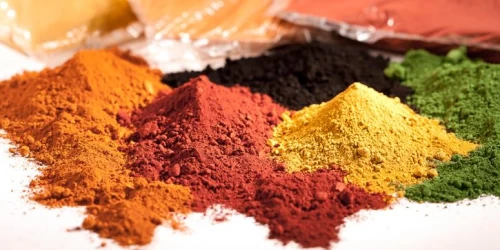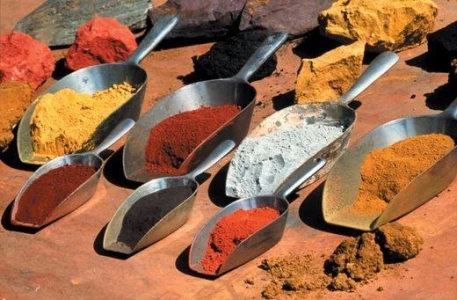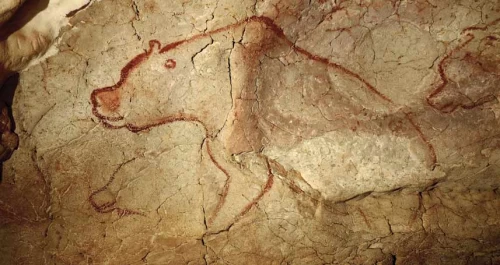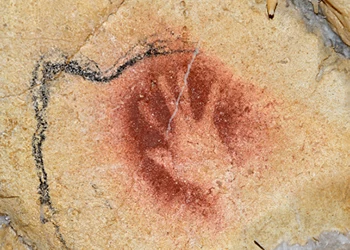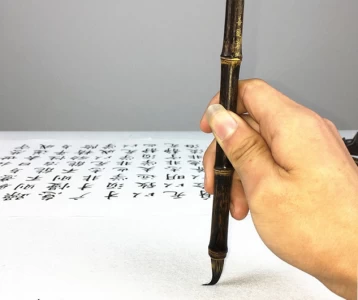Throughout history, man has tried to fix drawings and colours by adapting to places and surfaces.
Painting has been one of the most natural and widely used forms of artistic expression.
The first cave paintings date back 15 to 20 thousand years and can claim to be at the origin of the profession of "decorative painter".
Painting has been one of the most natural and widely used forms of artistic expression.
The first cave paintings date back 15 to 20 thousand years and can claim to be at the origin of the profession of "decorative painter".
The earth, so varied in colour, has always been the basis of the techniques that have barely changed until today.
Mixtures of ochres, charcoal and animal fat were enough to express human life on the walls of the caves.
Frozen by successive calcite flows, these paintings have been surprisingly preserved until today.
Frozen by successive calcite flows, these paintings have been surprisingly preserved until today.
Fingers were used to paint, bird feathers, moist or frayed pieces of wood and hollow tubes through which the pigments were blown.
Around 2000 years before Christ, the Chinese had the idea of placing tufts of animal hair in bamboos in order to be able to write their ideograms. This is the birth of the brush.
Around 2000 years before Christ, the Chinese had the idea of placing tufts of animal hair in bamboos in order to be able to write their ideograms. This is the birth of the brush.
The fresco processes known as "A fresco" were born around 1800 before Christ in Mesopotamia and then in Egypt thanks to the creation of lime kilns.
The fresco technique is comparable to cave paintings in the process of fixing by the surface calcite crust that traps the pigments.
In practice, an experienced fresco artist would make about 1 square meter per day.
The fresco technique is comparable to cave paintings in the process of fixing by the surface calcite crust that traps the pigments.
In practice, an experienced fresco artist would make about 1 square meter per day.
In Egypt, figurative representations and hieroglyphics were abundant. We will even find the realization of fake marbles in the tombs.
Later, the Greeks structured the walls of the buildings with panels of fake marble following the architectures to enhance them.
As for the Romans, they used the fresco in a more decorative way. Pompeii remains the undisputed example and apogee of decorative painting from Antiquity.
Later, the Greeks structured the walls of the buildings with panels of fake marble following the architectures to enhance them.
As for the Romans, they used the fresco in a more decorative way. Pompeii remains the undisputed example and apogee of decorative painting from Antiquity.
After a sharp decline during the fall of the Roman Empire, decorative painting was lost and only regained its nobility during the Italian Renaissance.
In general, the evolution of decorative painting will involve churches, great monuments and palaces.
In general, the evolution of decorative painting will involve churches, great monuments and palaces.
In France, it was in 1258 that the profession of decorative painter became official by bringing together the corporations of "painters" and "illuminators".
These painters adorned the walls of churches to highlight and embellish architecture but above all to reproduce biblical illustrations.
These painters adorned the walls of churches to highlight and embellish architecture but above all to reproduce biblical illustrations.
The mastery of oil painting in the 15th century gradually replaced this ancestral art. There is very strong competition between Italians and Flemings.
Despite its slow drying time, the thinness and smoothing of the oil painting layer on thin, transportable or even "rollable" supports such as canvases are now possible.
Despite its slow drying time, the thinness and smoothing of the oil painting layer on thin, transportable or even "rollable" supports such as canvases are now possible.
Decorative painters will use oil paint and will sometimes turn to the technique of marouflage. The trompe l'oeil are painted in the workshop and glued on site. The comfort of the workshop being irreplaceable.
In the 19th century, the industrial revolution provided painters with essential answers and technical progress, such as the creation of the painting tube with a ready-to-use oil painting or the creation of metal rings that bind the bristles to the handle of the brush.
In the 19th century, the industrial revolution provided painters with essential answers and technical progress, such as the creation of the painting tube with a ready-to-use oil painting or the creation of metal rings that bind the bristles to the handle of the brush.
The evolution of decorative techniques took place in parallel in France and England with mutual influence and then spread throughout Europe.
Since 1882, the Institut supérieur de la peinture décoratif Van Der Kelen in Belgium has been the first school in the world that is still the reference today to teach in a professional way the techniques of imitation of fake wood, fake marble and various materials.
Since 1882, the Institut supérieur de la peinture décoratif Van Der Kelen in Belgium has been the first school in the world that is still the reference today to teach in a professional way the techniques of imitation of fake wood, fake marble and various materials.
Unlike easel painters who express themselves through their works, the decorative painter creates a tailor-made universe at the service of others. Decorative painting is undoubtedly part of our heritage.
Witnesses of their time, trends, styles, new products, the decorative painters are in constant evolution and adapt to the requirements of their customers.
Witnesses of their time, trends, styles, new products, the decorative painters are in constant evolution and adapt to the requirements of their customers.
The decorative painter is sometimes an artisan, or even an art artisan for some, or a painter for others. What is its real status? The boundaries between these denominations at the same suffixes are however well definable...
All of them produce works: Some work with predefined and proven techniques, without leaving the part to chance, it is the artisans or art artisans. Their names vary according to their level of competence.
All of them produce works: Some work with predefined and proven techniques, without leaving the part to chance, it is the artisans or art artisans. Their names vary according to their level of competence.
For others, known as "artists", freedom, spontaneity, inspiration and even talent are the key words, but is it possible to create a work without relying on specific techniques such as those of artisans? In fact, the artist diverts learning techniques and advances by improvising, but we cannot say that he does not possess any technique...
Decorative painters sometimes have the term "decorative painter" but it is often confused with that of "decorative painting", a term widely used by building painters who wish to be closer to the world of decoration but who have neither the title nor the training.
The profession welcomes a new generation of decorative painters: the "muralists".
Some decorative painters were already working in the world of painted publicity, but recently they have had the task of dressing the urban space with monumental paintings.
The profession welcomes a new generation of decorative painters: the "muralists".
Some decorative painters were already working in the world of painted publicity, but recently they have had the task of dressing the urban space with monumental paintings.
The work of the decorative painter nowadays, through my achievements
Fake wood, fake marbles, fake cut stone, etc...
These are imitations in general, such as wood, marble, stone, wrought iron, bronze, leather, etc... These are sometimes ancestral methods and techniques.The materials
The "effects" of today's materials are often called "patinas". These techniques are used everywhere, they can be created at will according to the places and atmospheres. In relief or smooth, once varnished, they can be kept much longer than a simple single paint because they are protected and the movements of tints are tolerant and anticipate its ageing.The gilding
The decorative painter is not a full-fledged gilder but satisfies a large number of achievements. He knows how to place gold, silver, brass, platinum leaf, etc.Evolution of the decorative painter towards the painter artist, through my creations
The trompe-l'oeil
Hand painted decorations creating the illusion of applied relief and perspective on the walls or on the ceiling.Panoramic views
Painted decors opening onto vast expanses and landscapes, enhanced by architectural effects in the foreground in trompe-l'oeil.The floors
Glazed decorations or simple gluing using the floor texture.Painted furniture, paintings, objects
Everything can be decorated !Outdoor decorations
This section contains all outdoor decorative work carried out exclusively with outdoor acrylic paints in order to preserve the colours against UV and bad weather as best as possible over time.Evolution of the painter artist towards interior architecture, through my achievements
Interior design
The parallel between decorative painting and interior design has led me to create design concepts that are realized with partner or local companies. Very often, I realize and complete all the projects with materials or various creations that I realize myself on site.Since time immemorial, decorative painters have had to adapt to new products, develop their techniques and find new ones to mark their time. Times and fashions force them to constantly question themselves and find new ideas.
Many decorative painters have worked for wallpaper manufacturers and have shared their secrets. Silkscreen printing has long since abolished the profession of literary painter and many projects are carried out using digital printing. The size of the screens will reduce the surfaces to be decorated more and more.
Many decorative painters have worked for wallpaper manufacturers and have shared their secrets. Silkscreen printing has long since abolished the profession of literary painter and many projects are carried out using digital printing. The size of the screens will reduce the surfaces to be decorated more and more.
We are currently in a period where decoration is everywhere but especially in magazines. The minimalism pushed to its extremes by architects, perhaps for ease, has made them forget the decorative performances of their elders. The decoration is created by many virtually but realized by few people. Computer graphics and 3D views make it possible to project oneself "too" easily while the reality of the worksites is selective and expensive.
Despite current trends and the progressive cultural loss of the new generations, the profession of decorative painter still makes many young people dream and will always have a future. Since the dawn of time, man has always sought to realize himself, express himself and embellish his environment.
Despite current trends and the progressive cultural loss of the new generations, the profession of decorative painter still makes many young people dream and will always have a future. Since the dawn of time, man has always sought to realize himself, express himself and embellish his environment.


